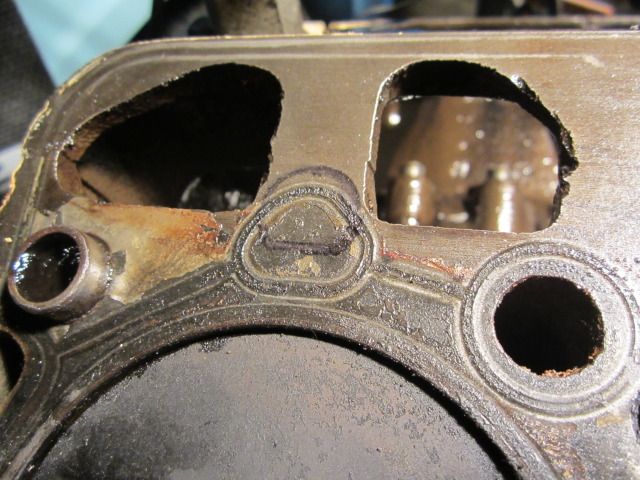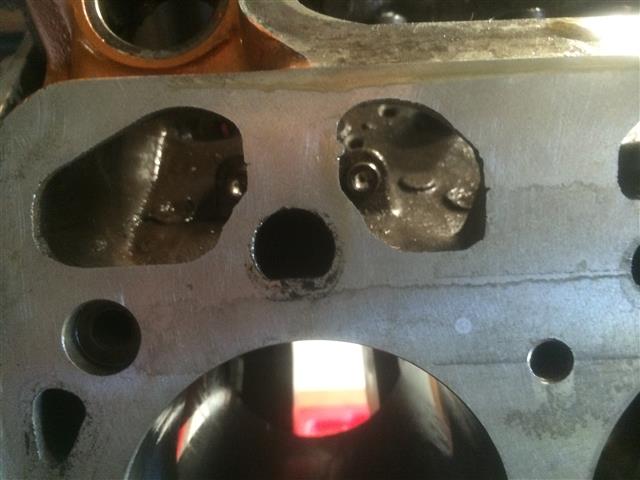|
Author
|
Message
|
|
Dobie
|
|
|
Group: Forum Members
Last Active: 2 Years Ago
Posts: 476,
Visits: 22.0K
|
Thanks Pegleg. I've used it several times on different engines. The secret is to follow the directions, a lot of people don't do that and get into big trouble with it. I take the extra step of rinsing it out of the radiator before it can dry. Never had a problem with it.
|
|
|
|
|
pegleg
|
|
|
Group: Forum Members
Last Active: 3 Years Ago
Posts: 3.0K,
Visits: 8.7K
|
Dobie/Dennis; If you don't want to use the Sodium Silicate at home there will be a commercial company somewhere near you that can do it. they also can use a vacuum process (Autoclave) that pulls a vacuum on the casting, then introduces the sealant. That method will then allow atmospheric pressure to force the sealant into the crack. Works pretty well. Most foundries now use an epoxy sealer now which is better but will not stand combustion temperatures. Sodium silicate will.
Frank/RebopBristol, In ( by Elkhart) 
|
|
|
|
|
NoShortcuts
|
|
|
Group: Forum Members
Last Active: 2 Years Ago
Posts: 1.4K,
Visits: 179.6K
|
pintoplumber (12/4/2014)
Gordon, here's a picture of a 239 early block. The picture is of cylinder #4. Does your block look like this ? If you have a water passage where the black magic marker circle is, you have a later block and the newer heads will fit. If you have the water passage to the right of cylinder #4 , you have an early block. Later heads can be put on an early block with a little work. I can post how I did it.  THANKS for the info. and the corresponding picture, Dennis. I've never been clear on how to differentiate between the early and late '54 blocks. From what Paul mentioned, am I understanding that determining which iron foundry made the block, will tell the story, too?
NoShortcuts
a.k.a. Charlie Brown
near Syracuse, New York
|
|
|
|
|
314
|
|
|
Group: Forum Members
Last Active: 7 Years Ago
Posts: 287,
Visits: 1.7K
|
if its a 55 truck head all later parts fit.the block is the same as 272.i had one .
|
|
|
|
|
Y-Block Y-not
|
|
Hitting on all eight cylinders
Group: Forum Members
Last Active: 11 Years Ago
Posts: 8,
Visits: 29
|
Hi Dennis Confirmed that there is a water passage as required to fit the newer heads - thanks that's a ray of sunshine - now to find a pair of heads (and probably a new inlet manifold to match) Cheers  .
|
|
|
|
|
Dobie
|
|
|
Group: Forum Members
Last Active: 2 Years Ago
Posts: 476,
Visits: 22.0K
|
Water glass is sodium silicate, a common ingredient in most liquid block sealers. If done properly it's a permanent repair but it's not for the fainthearted, so if you use it be sure to follow the directions to the letter.
|
|
|
|
|
Y-Block Y-not
|
|
Hitting on all eight cylinders
Group: Forum Members
Last Active: 11 Years Ago
Posts: 8,
Visits: 29
|
Hi Gordon here - thanks for the help with the weld repair info - even if I find another head I think I'll be getting this one repaired - they are just too hard to find here
Dobie - Sorry for the ignorance but what's "Water Glass" - I've never heard that name or term before
Dennis - Mate thank you I think that's the piece of the puzzle I needed - I should be matching heads to the block rather than trying to find an alternate for the heads I have - I'll check the block tonight and let you know if I need your wisdom
A photo of the old girl when I found her
|
|
|
|
|
pintoplumber
|
|
|
Group: Forum Members
Last Active: 4 hours ago
Posts: 1.0K,
Visits: 164.2K
|
Gordon, here's a picture of a 239 early block. The picture is of cylinder #4. Does your block look like this ? If you have a water passage where the black magic marker circle is, you have a later block and the newer heads will fit. If you have the water passage to the right of cylinder #4 , you have an early block. Later heads can be put on an early block with a little work. I can post how I did it. 
 Dennis in Lititz PA Dennis in Lititz PA
|
|
|
|
|
Dobie
|
|
|
Group: Forum Members
Last Active: 2 Years Ago
Posts: 476,
Visits: 22.0K
|
I had luck in finding a shop that specializes in industrial casting repair when I had my flathead fixed. He didn't use the Lock'nStitch method, though. He used the Irontite method. I had a crack in one combustion chamber from the exhaust valve seat, across the chamber and down about 3/8" into the cylinder. He sewed that one up plus the "part number" cracks in the deck between water holes, all for $150. Then my machinist pal sleeved the cylinder. I have driven the car many thousands of miles since with no problems. I do suggest backing up the repair with water glass; it's cheap insurance.
|
|
|
|
|
2721955meteor
|
|
|
Group: Forum Members
Last Active: Last Year
Posts: 927,
Visits: 190.0K
|
no shortcuts, the proces you showed is excellent,we use to sows up cracks in early (2u,13a series d8 dozers trans cases,as well as engine blocks). the only aria it did not work was combustion aria of cylender heads. but water jacket and oil eras it is as strong as the original casting.Problem hear is getting some one to do it. hear it was called harmen chain lock. i would recommend that proses if you could find a shop that is experienced
|
|
|
|